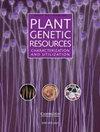Genetic structure analysis and genetic fingerprinting of pomegranate cultivars (Punica granatum L.) by using SCoT molecular markers
IF 0.7
4区 生物学
Q3 PLANT SCIENCES
Plant Genetic Resources: Characterization and Utilization
Pub Date : 2023-07-10
DOI:10.1017/s1479262123000394
引用次数: 0
Abstract
Genetic diversity and genetic relatedness among 50 genotypes from eight countries, including Iran, Afghanistan, Turkmenistan, Syria, Lebanon, India, Yemen, and the United States located in two continents of Asia and the America, were assessed using SCoT markers. A total of 213 bands were produced; 100% of them were polymorphic; the average polymorphism information content (PIC) was 0.39. The mean Nei's gene diversity and Shannon's index were 0.33 and 0.49, respectively. Analysis of molecular variance suggested significant genetic differences within pomegranate populations. 99% of variance occurs within the populations, whereas 1% of the variation was recorded among the populations of pomegranate. Cluster analysis using SCoT markers able to group genotypes based on their geographical origins. Based on cluster analysis, the genotypes studied were divided into two main groups. The first group included most Asian genotypes, while American genotypes along with some Asian genotypes were in the second group. In the first group, Iranian genotypes were grouped with genotypes from Afghanistan and India. In the second group, the genotypes belonging to the America were in the same group as most of the genotypes of Turkmenistan. According to the present study, SCoT markers can be used to evaluate genetic diversity, identification and DNA fingerprinting pomegranate genotypes of different origins. This information can be used in breeding programs and the management of pomegranate collections.利用SCoT分子标记分析石榴品种遗传结构及遗传指纹图谱
利用SCoT标记对来自亚洲和美洲两大洲的伊朗、阿富汗、土库曼斯坦、叙利亚、黎巴嫩、印度、也门和美国等8个国家50个基因型的遗传多样性和遗传亲缘性进行了分析。共生产频带213条;100%为多态;平均多态性信息含量(PIC)为0.39。平均Nei’s基因多样性和Shannon’s指数分别为0.33和0.49。分子变异分析表明石榴居群间遗传差异显著。99%的变异发生在种群内,而1%的变异发生在石榴种群之间。利用SCoT标记进行聚类分析,能够根据地理来源对基因型进行分组。通过聚类分析,将所研究的基因型分为两大类。第一组包括大多数亚洲基因型,而第二组是美国基因型和一些亚洲基因型。在第一组中,伊朗基因型与来自阿富汗和印度的基因型分组。在第二组中,属于美洲的基因型与土库曼斯坦的大多数基因型在同一组。根据本研究,SCoT标记可用于评价不同来源石榴基因型的遗传多样性、鉴定和DNA指纹图谱。这些信息可用于石榴的育种规划和管理。
本文章由计算机程序翻译,如有差异,请以英文原文为准。
求助全文
约1分钟内获得全文
求助全文
来源期刊

Plant Genetic Resources: Characterization and Utilization
Agricultural and Biological Sciences-Agronomy and Crop Science
CiteScore
2.80
自引率
0.00%
发文量
29
审稿时长
>12 weeks
期刊介绍:
Plant Genetic Resources is an international journal which provides a forum for describing the application of novel genomic technologies, as well as their integration with established techniques, towards the understanding of the genetic variation captured in both in situ and ex situ collections of crop and non-crop plants; and for the airing of wider issues relevant to plant germplasm conservation and utilisation. We particularly welcome multi-disciplinary approaches that incorporate both a technical and a socio-economic focus. Technical aspects can cover developments in technologies of potential or demonstrated relevance to the analysis of variation and diversity at the phenotypic and genotypic levels.
 求助内容:
求助内容: 应助结果提醒方式:
应助结果提醒方式:


